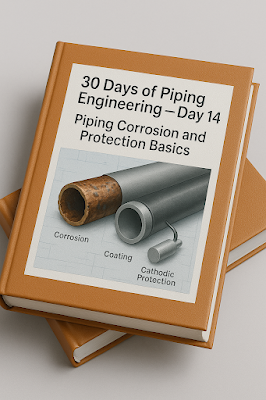30 Days of Piping Engineering – Day 14: Piping Corrosion and Protection Basics
Welcome to Day 14 of our 30 Days of Piping Engineering! We’ve covered materials selection, valves, supports, and more. Today, we’re diving into piping corrosion and protection—key factors in ensuring the longevity and safety of your piping systems.
What Is Piping Corrosion and Protection?
Corrosion is the degradation of pipe materials due to chemical or electrochemical reactions with the environment, such as water, air, or soil. Protection methods are used to prevent or minimize this damage. Here’s an overview:
- Types of Corrosion:
- Uniform Corrosion: Even material loss across the surface, common in carbon steel pipes exposed to moisture.
- Pitting Corrosion: Localized pits, often seen in stainless steel in chloride-rich environments like seawater.
- Galvanic Corrosion: Occurs when two dissimilar metals are in contact, accelerated by an electrolyte like saltwater.
- Protection Methods:
- Coatings: Epoxy or polyethylene coatings shield pipes from corrosive elements, widely used on buried pipelines.
- Cathodic Protection: Uses sacrificial anodes (e.g., zinc) or impressed current to prevent corrosion, common in offshore oil platforms.
- Material Selection: Choosing corrosion-resistant materials like stainless steel or alloys for aggressive fluids.
- Inhibitors: Chemicals added to the fluid to reduce corrosion rates, often in cooling water systems.
- Monitoring: Regular inspections with techniques like ultrasonic testing help detect corrosion early, preventing failures.
Effective corrosion protection extends pipe life, reduces maintenance costs, and ensures safety, especially in harsh environments like chemical plants or marine settings.
Real-World Example
In a coastal refinery, cathodic protection was applied to steel pipelines to combat saltwater corrosion, adding decades to their service life and avoiding costly replacements.
Did you know ?
The first known use of corrosion protection dates back to the 1820s? Sir Humphry Davy used zinc anodes to protect copper sheathing on British naval ships, laying the groundwork for modern cathodic protection techniques!
Your Day 14 Takeaway
Understanding piping corrosion and its protection is vital for durable systems. Mastering these basics helps you safeguard your designs against environmental challenges. Tomorrow, we’ll explore piping design software—see you then!
